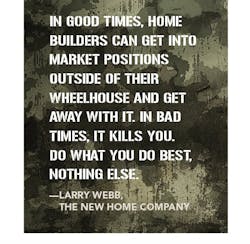In “The Next Housing Downturn—Is It Too Late to Get Ready?” I noted that many pundits and provocateurs predict a slowdown of some note in early 2020, and how one industry authority has proclaimed it already too late to prepare. I spent the remainder of that article detailing specific things builders can do to simultaneously improve their current operations and prepare for the possibility of a downturn. I developed those ideas watching and working with survivors of the last big crash, combined with what my firm, TrueNorth, has learned through more than 200 Lean Process implementations.
The next logical step: query some of those survivors and ask for their recommendations. What do they suggest builders do to prepare for what will come, sooner or later?
Their responses are interesting, ranging from common, expected themes to divergent opinions. These are the voices of experience.
Larry Webb
The New Home Company, Aliso Viejo, Calif.
Larry is an industry legend, from his time developing John Laing Homes into a powerhouse and selling it just prior to the last big housing crash, to his launch of The New Home Company, now operating divisions in Northern and Southern California and Arizona. Here are Larry’s recommendations.
1. Reduce your general and administrative expense (G&A). In good markets, staff numbers get bloated and salaries escalate—in particular, look at your highest-price team members.
2. Lower your leverage. Whatever it is, reduce it.
3. Save your cash. Buy less land and save money for rainy-day opportunities.
4. Refocus your team. In good times, home builders can get into market positions outside of their wheelhouse and get away with it. In bad times, it kills you. Do what you do best, nothing else.
5. Remember: Culture and people matter even more during bad times. Evaluate everyone and focus on your stars at every level.
Don Hubble
Hubble Homes, Boise, Idaho
Don Hubble, founder and president of Hubble Homes, is a straight-shooter, a solid builder, and is very involved in his Boise community. He keeps it simple, with this admonition: “I have one major belief,” he says, “and it’s probably the same No. 1 on everybody’s list: Don’t pay cash for land right now at today’s market value.”
Dave Erickson
Grayhawk Homes, Columbus, Ga.
While fighting the housing recession, Dave, the founder and president of Grayhawk Homes, also fought off much larger builders from Atlanta trying to nab a share of his market.
He was successful on both fronts and has this to tell you: “First, if you own a big land position, make sure your finances have durability. That applies universally, but it now becomes critical. Second, you must ask, if you had passed on that land position, who would have gotten it instead, and then what happens if interest rates U-turn on you, as happened during the first two quarters this year? Finally, if we do get a slowdown, as soon as you're convinced it’s real, don’t be slow to cut costs and people. That was my weakness in the last downturn: I was too slow to adjust staff to the new reality.”
Scott Dirkschneider
Brookline Homes, Charlotte, N.C.
Before launching fast-growing Brookline Homes in 2014, company president Scott Dirkschneider gained a wealth of experience with both national and local builders. His 40 years in home building, preceded by degrees in both architecture and construction management, give him a rare perspective.
Scott says: “I see many builders, especially the nationals, running around like Chicken Little, proclaiming ‘The recession is coming. Don’t buy land! Don’t buy any more land!’ It’s not too late to prepare for a recession, but it will be easier for some than for others. It surprises me the number of builders who seem to forget what they learned in the last recession. The smaller builders can actually prepare for a recession much more quickly and easily than the typical national.
To survive, we must become, then stay, Lean in every aspect. We have only 20 plans—I wish it was 10—across seven communities, and we purposefully offer very few options. If every buyer is asking for it, we make it standard and raise the base price. Our salesforce is commission-based, our variance to total cost is less than 0.2%. Our staff-to-home ratio is >13 homes per employee. We buy most of our lots on an option basis. Land will bury any builder that isn’t prepared financially for the next downturn. Finally, having gone through LeanWeek, we continue to discover new ways to improve product and process and apply Lean to our bottom line. Being Lean definitely gives us a leg up.”
Todd Booze
Ideal Homes (retired), Oklahoma City, Okla.
As a co-founder and president of award-winning company Ideal Homes, Todd sold his share of the business to his former partners earlier this year and is now retired, although no one who knows Todd believes that will last for long.
A long-time examiner for the National Housing Quality Award, Todd adds a couple of items most others overlook:
1. Technology: “Many builders use multiple databases because employees create their own spreadsheets to manage their process, forgoing the fully integrated software they have because they ‘just don’t like it.’ We ran into that and it created a lot of work behind the scenes because people held on to their sacred cows. You must get your technology and databases in order.”
2. The million dollar question: “How many of these builders are working with their trades to help the trade improve, which in turn helps the trade’s relationship with the builder and results in better pricing? We have waste in our own systems for sure, but think of the cost of waste in our trades and vendors, in how they do things. I always try to work with individual trades where I see obvious problems and I discuss issues at meetings with them, but there is nothing better than going to their playing field and helping them. It’s tough to do; we have so much to work on in our operations. Yet there are tremendous opportunities if we help others get what they need, then we in turn will get what we deserve.”
John Allen
Brown Haven Homes, Blairsville, Ga.
John Allen is one of those visionary leaders who goes his own way, always thinking first of what he can do, instead of what he can’t. From its small-town north Georgia base, Brown Haven Homes is rapidly expanding its on-your-lot business into North and South Carolina, building great homes in beautiful settings.
John steps back to a macro level and asks some intriguing questions. “First, our margins shouldn’t be so thin as to dramatically alter the way we do business when the slowdown comes. But I question the entire premise because so many experts who missed it last time are once again selling fear. The contrarian in me thinks, ‘If all those guys are going left, then I’ll go right.’” He identified trends that go against the fear of recession, including:
1. Fed Chairman Powell hinting at rate decreases.
2. No real leverage in the system, meaning debt is low.
3. Real talent and labor shortages, aka low supply = more demand.
4. Global large-scale capital is flooding to the U.S. for yield due to insane ZIRP [zero interest rate policies] by central banks around the world.
“I suggest you request written points on why the ‘experts’ are predicting a recession—other than an inverted yield curve—and it has been too long since the last recession. Ask them about how the entire central banking world is moving toward ‘Modern Monetary Theory,’ as the ‘Efficient Market Hypothesis’—the basis for business decisions since World War II—is becoming more outdated by the minute. I have a hunch this may not make it into the article.” (Editor’s note: Of course, this made it, John! We love contrarian views.)
Marc Rousso
JayMarc Homes, Seattle
Marc Rousso and his partner Jay Mezistrano are two of the most interesting and passionate builders you’ll ever meet, in a truly unique market, Mercer Island and Bellevue, Wash. With zero vacant land, each lot is a tear-down, and base prices start at about $2.1 million, most selling for far more. The two former college DJs built a substantial company, but JayMarc got beat up thoroughly in the last recession, and they vowed, never again.
Marc reports, “We faced a ‘slowdown’ here in Seattle from July [2018] to March of this year. During that time, each of the 10 moves below came into play. As is our policy, we had 1 ½ years of overhead in the bank, and we needed 50% of it to weather the slowdown, paying for overhead and extra expenses the lenders required from us.”
1. Reduce cost of overhead and “B” players now. Keep the best of the best on the team. The rest will understand. JayMarc let three people go in October and has only added one part-time person since.
2. Purchase land that has a quick turn, preferably finished lots on take-down schedules.
3. Start negotiating with multiple vendors and suppliers ahead of a downturn. JayMarc actively sought out other vendors to bid against the old guard and it proved very beneficial.
4. Value-engineer plans by working with vendors and suppliers. The builder is doing this with all of its new plans this year and it is helping immensely.
5. Monitor, then eliminate variance purchase orders by adding them into scopes of work.
6. Reduce cycle time in buying, permitting, building, and selling the home. Create a better even flow and Lean manufacturing program. “We all went to Lean/Kaizen training and made it a part of our values,” Marc says.
7. Build a bucket of cash, at least one year of overhead, not used for acquisitions.
8. Create a pool of investors that can jump on opportunities when the downturn arrives.
9. Take care of your team members by being honest and transparent with where things are in the business and the market.
10. Follow The Great Game of Business by Jack Stack. “We always have done this,” Marc says. “Everyone loves the transparency.”
Bill Saint
Classica Homes, Charlotte, N.C.
Bill Saint was president and CFO at Simonini Builders when it received the National Housing Quality Gold Award in 2001 and led his own company, Classica Homes, to NHQ Gold two years ago. If you seek great product coming from an exceptional culture, visit Classica.
Bill says the best defense is a good offense: “I say, after going through the last downturn, defense sucks. It’s no fun. It’s demoralizing. I will retire if I have to play defense to survive. Might as well watch bowling—just as boring! Offense is about sales. Offense is about inspiring customers to buy when the world says no. Offense is about keeping your team engaged to grow, think, work hard, sweat, and create the remarkable. I say, offense!”
Mark Adler
Mark Adler Homes, West Bloomfield, Mich.
When I launched TrueNorth 22 years ago, Mark was one of my first two clients, and he has experienced it all, doing whatever it took to get through the last housing crash and emerging with a new company and a different approach.
Mark puts it in plain language, with a touch of humor—something we’ll need as we march on toward this downturn, which may or may not be just over the horizon: “I see a slowdown, not a crash,” he says. “I just plan on staying a bit aggressive, but not crazy. I see the young guys with no battle scars going crazy and I wonder about their fate.”
He adds: “Don’t sign personally. If you absolutely must sign personally, then DO NOT HAVE YOUR WIFE SIGN! One thing you can count on when it comes to builders and developers is that we are the ultimate optimists. An old-timer—even older than me—told me: ‘When a steamroller runs over a builder/developer, all that’s left is a Rolex watch and two brass balls.’ For me, I never have—nor will I—own a Rolex watch.”
Scratching the Surface
This is a good start, but there’s much more to consider. George Casey, another industry legend and the CEO of real estate consulting firm Stockbridge Associates, sent me a slide presentation he put together after the last housing recession. The presentation is so rich in content that summing it up would take an entire column, so stay tuned for that.
Meanwhile, the one thing we we’d like to avoid is the self-fulfilling prophecy. If we expect a slowdown, will we hasten its arrival? If we aggressively plan for it, will we make it worse? There is an entire field called “behavioral economics” that deals with psychological and sociological impacts on economies, and my review of some of the literature makes it perfectly clear: Sometimes expectations move markets, sometimes they don’t. That’s not much help.
Some may say we shouldn’t even raise the issue, just keep on keepin’ on. But to adapt some phrasing from Neil Young: “I’ve seen the recession and the damage done.” It was horrific. Half of U.S. builders—and an even greater percentage of the trades—went under.
I challenge you to find any builder who will say we couldn’t have been better prepared. So, we’d best heed the words of the survivors. Almost no one believes the next slowdown will be as bad as the previous one a decade ago. Yet if it’s just half as bad, even one-third as bad, we’ll all have our work cut out for us to remain within the ranks of the survivors. Time to get started.
For a free PDF of “Process and Profit—Bridging the Margin Gap,” Scott’s collection of columns on finding margin in any market, email your request to [email protected]. You may reach Scott at [email protected] or 248.446.1275.
Access a PDF of this article in Professional Builder's September 2019 digital edition
About the Author

Scott Sedam
Scott Sedam is president of TrueNorth Development, a consulting and training firm that works with builders to improve products, process, and profits. A senior contributing editor to Pro Builder, Scott writes about all aspects of the home building business and won the 2015 Jesse H. Neal Award, business journalism's most prestigious prize, for his commentary in Pro Builder. Scott invites you to join TrueNorth's Lean Building Group on LinkedIn and welcomes your feedback at [email protected] or 248.446.1275.


